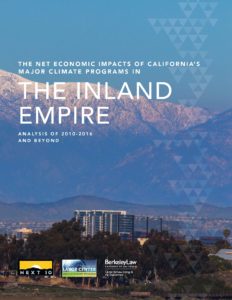With the legislature just passing a landmark extension of cap-and-trade through 2030 by a supermajority vote, attention now turns to implementing the state’s major climate programs to achieve the ambitious climate goals for that year and beyond.
Critics frequently argue that efforts to fight climate change hurt the economy and cost jobs. Yet as I blogged about a few weeks ago, research on California’s San Joaquin Valley and then-forthcoming from the Inland Empire show net positive results.
The Center for Law, Energy and the Environment (CLEE) at UC Berkeley Law and UC Berkeley’s Center for Labor Research and Education, working with the nonpartisan nonprofit Next 10, just released the first comprehensive cost/benefit study of climate policies in Southern California’s Inland Empire, one of California’s most environmentally vulnerable regions.
 The Net Economic Impacts of California’s Major Climate Programs in the Inland Empire: Analysis of 2010-2016 and Beyond examines the impact of four climate programs in the region, defined here as San Bernardino and Riverside Counties. We chose these counties as a follow-up to our San Joaquin Valley report due to the region’s environmental and economic challenges and because elected leaders from the area have asked questions about the impact of climate policies on their constituents.
The Net Economic Impacts of California’s Major Climate Programs in the Inland Empire: Analysis of 2010-2016 and Beyond examines the impact of four climate programs in the region, defined here as San Bernardino and Riverside Counties. We chose these counties as a follow-up to our San Joaquin Valley report due to the region’s environmental and economic challenges and because elected leaders from the area have asked questions about the impact of climate policies on their constituents.
The report analyzed not only the benefits of California’s climate and clean energy policies, but also compliance expenditures, investment expenses, and other costs.
After examining the data and using advanced modeling software, we found that the four key California climate and clean energy policies, including cap and trade, the renewables portfolio standard, distributed solar policies and energy efficiency programs (among the most important in California’s suite of climate policies) brought a net benefit of $9.1 billion in direct economic activity and 41,000 net direct jobs from 2010 to 2016 in the region, some of which are permanent and ongoing and many of which resulted from one-time construction investments.
We found that the overall benefits to the Inland Empire are likely to continue and grow through 2030, as the state strives to meet its newly legislated climate goals for that year, via SB 32 (Pavley, 2016), SB 350 (De Leon, 2015), and now AB 398 (Eduardo Garcia, 2017). Those efforts will require at least 50% renewables by 2030, a doubling of energy efficiency in existing buildings, and a robust cap-and-trade program through 2030.
Based on the findings in the Inland Empire, we suggest that policy makers wishing to continue these benefits focus on policies that reward cleaner transportation in this region, help disburse cap-and-trade auction proceeds in a timely and predictable manner, and create robust transition programs for workers and communities affected by the decline of the Inland Empire’s greenhouse gas-emitting industries, including re-training and job placement programs, bridges to retirement, and regional economic development initiatives.
You can access the full report via CLEE or Next 10’s websites and check out media coverage in Southern California’s Press-Enterprise and on KPCC, KFI, and KVCR radio.


